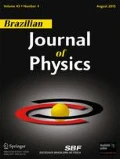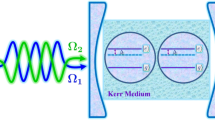Abstract
In this paper, the dynamics of entanglement between a single two-level atom interacting with one-mode cavity field is investigated with zero and large detuning parameters. The von Neumann entropy and concurrence measures are used to characterize the degree of entanglement. We find that the entanglement shows the oscillating behavior which depends on the initial amplitude of the coherent field, detuning parameter, and atom-field coupling constant. Specially, we study the generation of the robust maximally entangled state and conclude that the intensity of the coherent field and detuning parameter can be utilized as the control parameters for generating robust maximally entangled state. At the end, some important statistical features such as Wigner function, Mandel parameter, and second-order correlation function will be discussed. The comparison between the entanglement and Wigner function shows that for \(\chi t=(n+\frac {1}{2})\pi \), the maximum of Wigner function has information about the entanglement between the atom and field in the Jaynes-Cummings model. Moreover, the Mandel parameter and consequently the second-order correlation function show that the radiation field has Poissonian statistics.







Similar content being viewed by others
References
A. Einstein, B. Podolsky, N. Rosen, . Phys. Rev. 47, 777 (1935)
M. A. Nielsen, I. L. Chuang. Quantum Computation and Quantum Information (Cambridge University Press, Cambridge, 2000)
G. Benenti, G. Casati, G. Strini. Principles of Quantum Computation and Information (World Scientific Publishing Company, Singapore, 2004)
C. H. Bennett, G. Brassard, C. Crepeau, R. Jozsa, A. Peres, W. K. Wootters, . Phys. Rev. Lett. 70, 1895 (1993)
A. K. Ekert, . Phys. Rev. Lett. 67, 661 (1991)
D. Bouwmeester, J. W. Pan, K. Mattle, M. Eibl, H. Weinfurter, A. Zeilinger, . Nature. 390, 575 (1997)
E. T. Jaynes, F. W. Cummings, Proc. IEEE 51 (1963)
R. Juarez-Amaro, A. Zuniga-Segundo, A. Zuniga-Segundo, . Appl. Math. Inf. Sci. 9, 299 (2015)
S. B. Zheng, G. C. Guo, . Phys. Rev. Lett. 85, 2392 (2000)
L. Zhou, G. H. Yang, . J. Phys. B. 39, 5143 (2006)
Y. H. Hu, Y. G. Tan, . Phys. Scr. 89, 0751031 (2014)
N. Metwally, M. Abdelaty, A. -S. F. Obada, . Chaos, Solitons and Fractals. 22, 529 (2004)
S. B. Zheng, . Opt. Commun. 167, 111 (1999)
X. Q. Yan, . Chaos, Solitons and Fractals. 41, 1645 (2009)
J. S. Zhang, J. B. Xu, . Opt. Commun. 282, 2543 (2009)
K. Zeng, M. F. Fang, Chin. Phys. Soc. 14(10) (2005)
T. Yu, J. H. Eberly, . Science. 323, 598 (2009)
Q. Yang, M. Yang, Z. L. Cao, . Chin. Phys. Lett. 25(3), 825 (2008)
J. Cheng, X. Chen, C. J. Shan, . Int. J. Theor. Phys. 57, 1823 (2018)
Y. Ji, Y. Liu, . Optik. 127, 3211 (2016)
A. Karimi, M. K. Tavassoly, . Quant. Inf. Process. 15, 1513 (2016)
J. von Neumann. Mathematical Foundations of Quantum Mechanics (Princeton University Press, Princeton, 1955)
W. K. Wootters, . Phys. Rev. Lett. 80(10), 2245 (1998)
W. K. Wootters, . Quant. Inf. Comput. 1(1), 27 (2001)
E. Wigner, . Phys. Rev. 40, 749 (1932)
L. Mandel, . Opt. Lett. 4, 205 (1979)
R. J. Glauber, . Phys. Rev. 130, 2529 (1963)
C. Gerry, P. Knight. Introductory Quantum Optics (Cambridge University Press, Cambridge, 2005)
G. Najarbashi, S. Mirzaei, . Int. J. Theor. Phys. 55, 1336 (2016)
G. Najarbashi, S. Mirzaei, . Int. J. Theor. Phys. 55, 2311 (2016)
M. Hillery, R. F. O’Connell, M. O. Scully, E. P. Wigner, . Phys. Rep. 106, 121 (1984)
A. Banerji, R. P. Singh, A. Bandyopadhyay, . Opt. Commun. 330, 85 (2014)
G. Najarbashi, S. Mirzaei, . Opt. Commun. 377, 33 (2016)
S. Mirzaei, G. Najarbashi, . Rep. Math. Phys. 83, 1 (2019)
J.J. Sakurai. Modern Quantum Mechanics (Addison Wesley Publishing Company, Boston, 1999)
Author information
Authors and Affiliations
Corresponding author
Additional information
Publisher’s Note
Springer Nature remains neutral with regard to jurisdictional claims in published maps and institutional affiliations.
Appendix
Appendix
The Hamiltonian of the J-C model is \(\hat {H}=\hat {H_{0}}+\hat {H_{I}}\) where the interaction-free Hamiltonian is:
and the atom-field interaction Hamiltonian with the rotating-wave approximation is:
where \(\hat {A}=\hat {a}\hat {\sigma }_{+}\) and \(\hat {A}^{\dag }=\hat {a}^{\dag }\hat {\sigma }_{-}\). The time-dependent Schrodinger-like equation in the interaction picture is [35]:
with \({{\hat H}_{IP}(t)} = {e^{{i{H_{0}}t}/\hbar }}{H_{I}}{e^{- {i{H_{0}}t}/\hbar }}\). Using Baker-Hausdorf lemma, we have:
The solution of (A.1) is given by:
where \(\hat {\mathcal {T}}\) is the time-ordering operator. By substituting (A.2) in (A.3) and using perturbation expansion, after some simple algebra we found that:
clearly for △≫ λ the second and last terms are neglected and thus we have:
where
substitution \(\hat {A}\) and \(\hat {A}^{\dag }\) leads to the interaction Hamiltonian for the non-resonance case with large detuning as follows:
where \(\chi =\frac {\lambda ^{2}}{\varDelta }\).
Rights and permissions
About this article
Cite this article
Mirzaei, S. Dynamics of Entanglement and Statistical Properties in Atom-Field Interaction. Braz J Phys 51, 361–368 (2021). https://doi.org/10.1007/s13538-020-00852-w
Received:
Accepted:
Published:
Issue Date:
DOI: https://doi.org/10.1007/s13538-020-00852-w




